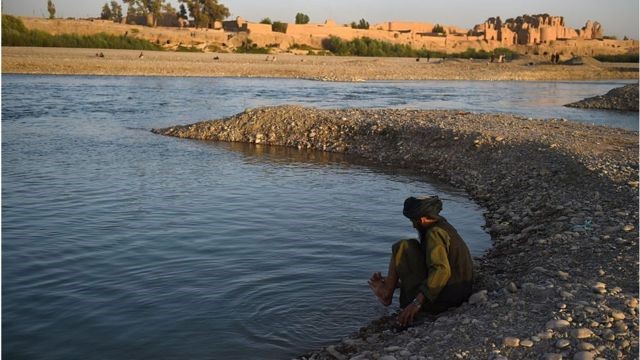What is the dispute between Iran and Afghanistan over the ongoing water?
Recently, the comments made by Afghan President Ashraf Ghani on Iran are indicative of the crisis arising out of water in the region.
On the occasion of the inauguration of Kamal Khan Dam in Afghanistan’s Helmand province, Ghani said that his country is committed to the rights of Iran’s water.
But he also said that additional water will be given instead of oil.
There was a strait between Iran and Afghanistan in the 70s. The Afghan government has been insisting on building a dam under it. But Iran is retreating, saying that the construction of such dams can damage the ecosystem in lakes and other areas.
Helmand: Old controversy
Two large rivers from Afghanistan go eastward to Iran. Helmand (also known as Heeramand) and Hari Rud.
The Helmand River is the lifeline for Hamun, the lake area situated on the border of both countries. Due to climate change, the area of this river is narrowing here due to which the life in Iran’s Sistan-Balochistan province has a negative impact.
The Helmand River is also at the center of a long-standing dispute between Iran and Afghanistan. Afghanistan has to supply 820 million cubic meters of water to Iran every year under a 1973 agreement between the two countries.
Apart from the Hamun Lake area, this water also passes through the shared border between the two countries.
In the year 2018, Iran’s Foreign Minister Zawad Zarif said that Iran will try to end the dispute with Afghanistan and will also include ‘Afghan refugees, illegal Afghan civilians, drug trade and smuggling’ in talks with Afghanistan. The Afghan government criticized this comment of Zarif.
Lose Rudd: Iran, Turkmenistan vs Afghanistan
Iran and Afghanistan have reached a settlement in February this year, ending a 50-year-old dispute over claims over the loss of the Rood River. This river flows from the central region of Afghanistan to the border of Iran.
Small rivers coming from Iran meet in Hari Rud and here also forms the border between Iran and Turkmenistan.
Iran and Turkmenistan together built the Friendship Dam on the Hari Rood River and it is also the main source of water for the Mashhad region.
Mashhad is the second largest city in Iran and also the capital of Khorasan Razavi Province. Afghanistan, along with India, built Salma Dam on the same river in 2006, which is above the Friendship Dam on the river.
In 2018, a member of the National Security and Foreign Policy Committee of Iran’s Parliament (Majlis) said that the dam built over the Friendship Dam on the Hari Ruad River could create a water crisis for Mashhad.
Abul Fazl Hasan Beeqi told the news agency ICNA, “Afghanistan is committed to the water agreement on the Helmand River, but its stand on the Hari Ruad river is not like this”.
Nightmare
There has been a lot of debate in the Iranian media in recent times about the construction of Afghanistan’s dam and it has affected the water supply for Iran.
The media, considered close to the government, received only a mild response to the statements of President Ashraf Ghani and Iranian Foreign Minister Zawad Zarif, but Fars and Tasneem, a news agency close to Iran’s powerful Revolutionary Guard, have strongly criticized Afghanistan
At the same time, Meezan news agency, which is leaning towards the radical judiciary, has described Afghanistan’s dam construction as bad for Iran.
A few days after Afghanistan’s Kamal Khan dam was commissioned, the Fars news agency said in an article that the water level in the river has not decreased in Afghanistan, despite that Afghanistan has not released as much water as it had promised.
Fars said that violating the 1973 agreement and reducing Iran’s share of water has put Hamun in danger. The news agency has said that the Kamal Khan Dam has increased Iran’s climate concern.
Committed to Iran’s water rights: Afghanistan
Najib Aqa Fahim, former minister of disaster management in Afghanistan and a university lecturer, has told the BBC that Afghanistan is committed to Iran’s water rights. He said that the concerns being expressed about the Kamal Khan dam are baseless.
Faheem says, “Iran receives about two billion cubic meters of water every year. This is more than the 82 million cubic meters of water Iran shares under the 1973 agreement. The reason is that it has been around for 40 years Afghanistan has not been able to use its water resources properly due to the wars. This dam, with a capacity of about 50 million cubic meters of water, is the only major project of Afghanistan that it has completed so far, while Iran has built dozens of dams on its side. Iran has not even given information about it to Afghanistan. “
Faheem says that Iran complains that Afghanistan does not have the ability to control floods and that it counts flood waters in Iran’s part.
He says that once the canals connected to the dam are complete, the water wasted due to floods can be handled to some extent and this will also improve the use of water sources between the two countries.
Attitude of Iran
Iran says it is trying to manage its share of water from both rivers in the wake of the uncertain outcome of the peace process in Afghanistan and unpredictable climate change.
When Fars News asked Energy Minister Reza Ardakanian if Iran had given up hopes of securing its share of water from Afghanistan, they said it was not so.
The Energy Minister said that Iran’s priority is to fix seawater. The Energy Minister was in fact pointing to a master plan to bring water from the Persian and Oman creeks into the country for domestic and industrial use.
Iran has limited water resources
Iran, which is located in the hot and dry region of the Middle East, gets only 240 to 280 millimeters of rain every year. This is well below the global average of 990 ml.
The eastern part of the country gets only 115 mm of rain annually. This area faces severe water crisis.
Iran has about one per cent of the world’s population, but here it is only 0.3 percent of the world’s fresh water. At the same time, 66 percent of the water received by the rain also evaporates before joining the rivers.
But Iran receives about nine billion cubic meters of water from the rivers flowing from neighboring countries. In such a situation, keeping in view the increasing water requirements of the country, it is necessary for Iran to secure the water from the rivers coming from the eastern neighboring countries.
Iran has separate disputes with its eastern and western neighbors over the sharing of water. Water from the rivers coming from Afghanistan and Turkmenistan is very important for Iran’s two major eastern provinces.
At the same time, the dispute over water with Iraq also has economic and strategic importance. The Shat al-Arab River divides Iran and Iraq. This is very important for both countries for shipping and production.
Iran is also unhappy about building a dam on Turkey’s Tigris and Euphrates rivers, as it could have a negative impact on Iran’s environment.




